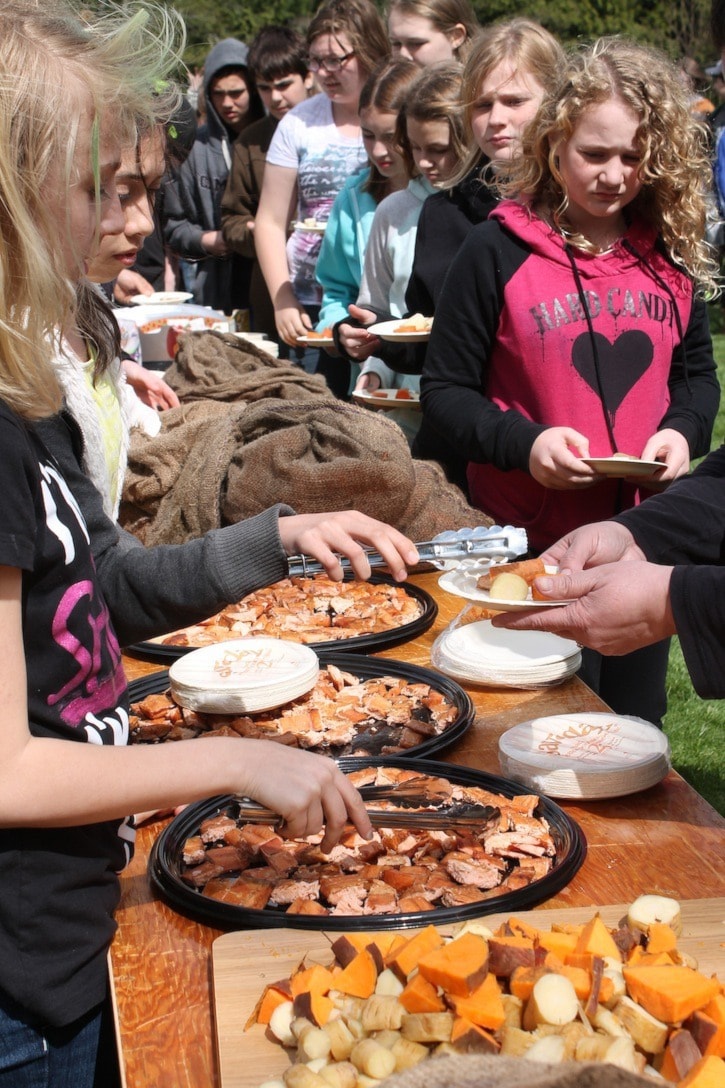On a windy Friday morning, Journey middle school saw early morning activity with the building of a pit and a morning-long cookout.
Principal Laurie Szadkowski introduced the event in an email. “Students and staff from Mt. Olympus and Atlantis Neighbourhoods will be treated to a feast of veggies, salmon and crab cooked in a pit in our school yard. A pit, dug by our Facilities Department, lined with stones from DeMamiel Creek and ferns from the forest will be used to help cook the food after the fire has left a bed of coals.”
Represented were the T’Sou-ke, Pacheedaht, and Tsawout Nations.
Elder Earl Claxton Jr. looked after the slow roasting of the salmon, while knowledge keeper John Bradley Williams (Tsawout Nation), who works under Elder Earl Claxton, looked after coordinating the Pit Cook. Williams explained the process to groups of Journey students.
First a deep pit is dug out, and lined with rocks along the bottom. A wood fire is started on top of the rocks in order to heat the rocks.
At Journey, the fire was started at 6 a.m. Once the rocks were heated, after three hours of being in the fire, the ashes were removed. Then, the pit is quickly filled and covered.
The filling process, which began shortly after 9:30 a.m., took a matter of minutes. The process began with placing a big wooden branch in the middle and then adding layers. These include a layer of green salal branches (which, Williams pointed out is an excellence source of Vitamin C), ferns, and skunk weed leaves (don’t worry, assured Williams, the stinky smell comes from the flowers, not the leaves). The salal and ferns protect the food and provide flavour; the skunk weed leaves act as catchers, should any food spill from their burlap sacks. Then, the vegetables in burlap sacks were placed on top of the greens, and quickly covered with the same layer (skunk weed, ferns and salal). Once all the greens were laid and the stick removed, three big pails of water were poured into the pit, sending billowing wafts of steam skywards. A tarp was quickly laid on top of the steaming pile and then covered with dirt.
On a separate fire, salmon was posted on a grill and positioned beside another fire. Claxton explained that the cooking process entailed four repositioning: after the first roasting, the top and the bottom are switched, then the grill is turned front to back, and then switched bottom to top. The process hardens the outer flesh, cooking up a tender and flavourful inside.
By 1 p.m., the food was cooked. The pit had to be carefully shovelled, the tarp rolled up, and the cooked greens removed. Burlap bags were carried to the waiting tables and the root vegetables taken out. At the same time, the salmon came off the grill.
After a prayer and blessing from T’Sou-ke Nation Elder Shirley Alphonse, with Michelle Wolf drumming, the elders were served, and then the students, too, could dine.
This Pit Cook was the first of two. Journey middle school has four neighbourhoods within. This Pit Cook was worked by — and enjoyed by — the Mt. Olypmus and Atlantis neighbourhoods. Next up, Utopia and Mystical Main will engage in the next Pit Cook, scheduled for April 25.
The event was tied to the pursuit of knowledge. “We just wanted to bring a little bit of culture (and) celebrate spring,” said Michelle Wolf, who is with Journey’s Aboriginal education program.
